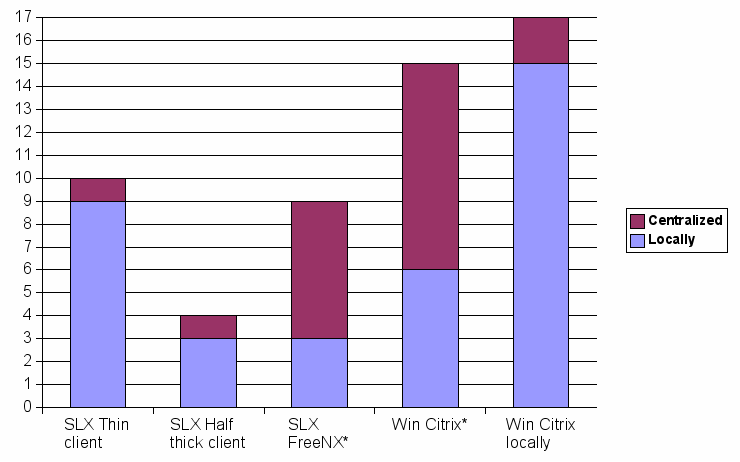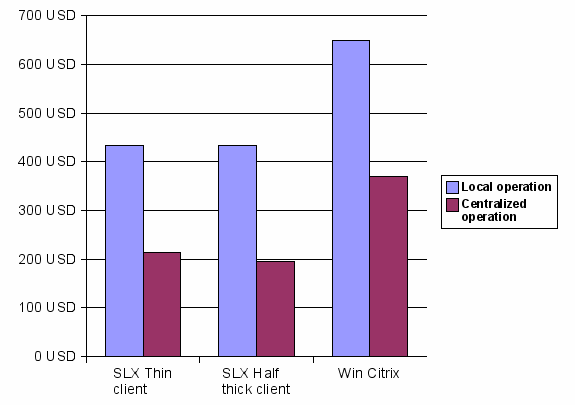
*) Centralized servers with 2-8 Mpbs to a remote location gives strong limitations when using media rich applications, as gimp or OpenOffice Draw. Then locally placed thin client servers are the solution.
|
Type |
Skolelinux with |
Skolelinux with half thick clients |
Skolelinux with |
Windows with |
Windows with |
|
Local servers |
9 (1 |
3 |
3 |
6 |
15 (1 |
|
Centralised servers |
1 |
1 |
6 (2 |
9 (2 |
2 |
|
Bandwidth if centralising the thin client servers |
High (low-middle when using locally placed servers) |
Low - middle |
Low - middle |
Low - middle |
Low - middle |
|
Pro |
Rady for ICT-based exams. Full reuse of old PC's with 133 MHz CPU |
Rady for ICT-based exams. Reuse of old PC's with 450 MHz CPU. Better utilisation of the bandwidth. Removes the need for thin client servers |
Can reduce the thin client servers to 60%. |
Can reduce the thin client servers to 60%. |
Can use older PC's with Linux based Citrix clients (TNT) |
|
Con |
More servers. Could trigger high expenses when hiring broadband. |
Half thick clients should have more CPU than 450 MHz. |
Need for two structures for software deplpyment (3 |
Need for two structures for software deplpyment (3 |
More servers (and even more than Skolelinux with LTSP) |
|
Running programs |
Locally |
Locally |
Locally and centralised |
Locally and centralised |
Locally |
Preconditions:
3 locations. 400 users and 150 terminals at each location.
Notes:
Advantage of the statistical fact that max 60% of the terminals are in use at the same time
A standard LTSP server can serve at least 50, probably 60 thin client. The number of Citrix clients to a standard Intel/AMD server is 30. This is verified with Microsoft Certified Systems Engineer1 in the municipal department of education) in Oslo and other organisations.
It's necessary with locally installed OS to host Citirx or FreeNX (NoMachine). Then we need 1 Linux-server og 2 Windows-servers for software distribution locally. This is verified with Microsoft Certified Systems Engineer in the municipal department of education) in Oslo and other organisations.

*) Centralized servers with 2-8 Mpbs to a remote location gives
strong limitations when using media rich applications, as gimp or
OpenOffice Draw. Then locally placed thin client servers are the
solution.
Every report from ICT-operations shows that there is a lot to save on centralised management. The savings are considerable larger with Linux than Windows.

The cost is annually divided on each computer. Foreign exchange
from Norwegian kroner to US Dollars (Exchange rate: NOK/USD
0.162464
2004-12-23). Source: Teleplan report (nov.
2003) on behalf of the Ministry of Trade and Industry. A Linux
report from The municipal department of education in Oslo (dec.
2004).
1Microsoft Certified Systems Engineer http://en.wikipedia.org/wiki/MCSE